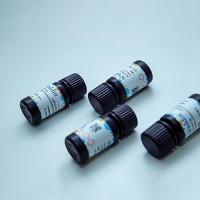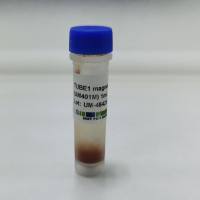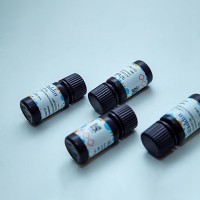In Vitro Selection of Peptides Acting on NMDA Receptors
互联网
663
Phage-displayed random peptide libraries have been used to identify novel agonists and antagonists to a wide variety of receptors. Among these are a family of peptides that bind to the NMDA receptor subunit NR1 and non-competitively inhibit receptor channel activity (
1
). The peptide libraries used to identify these ligands were constructed by cloning a collection of random oligonucleotides into the phagemid vector p8V2 (Fig. 1 ). Peptides encoded by the cloned oligonucleotides are displayed on the surface of phage particles fused to the N-terminus of the major coat protein pVIII. The expression of gene VIII in p8V2 is under the control of the inducible P
BAD
promoter (
2
), which allows one to produce phage particles with few or many copies of peptide-bearing pVIII relative to wild-type pVIII. Libraries were affinity-selected against a soluble form of the extracellular amino-terminal domain of NR1 produced by the method described in Chapter 5 in this volume (
3
). Individual isolates from the enriched pools were then characterized by a phage ELISA to identify clones that bound specifically to NR1. The sequence of peptides displayed by phage that bound to receptor was deduced by sequencing the cloned oligonucleotide contained in the virion. By this method, several peptide families were rapidly identified that specifically recognize the extracellular amino-terminal domain of the NR1 subunit.
Fig. 1.
Cloning scheme for constructing random peptide libraries in p8V2. (
A
) Structure of the oligonucleotide insert. The random codon containing oligonucleotide is annealed with two half-site oligonucleotides (ON-2, ON-3) to create a fragment with ends complementary to the two
Bst
XI sites in p8V2. The signal peptide cleavage site is located immediately upstream of the random region, and therefore, peptides are displayed fused to the amino-terminus of pVIII. (
B
) Map of the phagemid vector p8V2. Two noncomplementary
Bst
XI sites in the amino-terminus of gene VIII allow directional cloning of oligonucleotide inserts. The expression of gene VIII is under control of the P
BAD
promoter, which is positively and negatively regulated by the araC gene. The M13 intergenic region contains the replication origin used for (+) strand DNA synthesis, which occurs in the presence of gene productss supplied by the helper phage.







